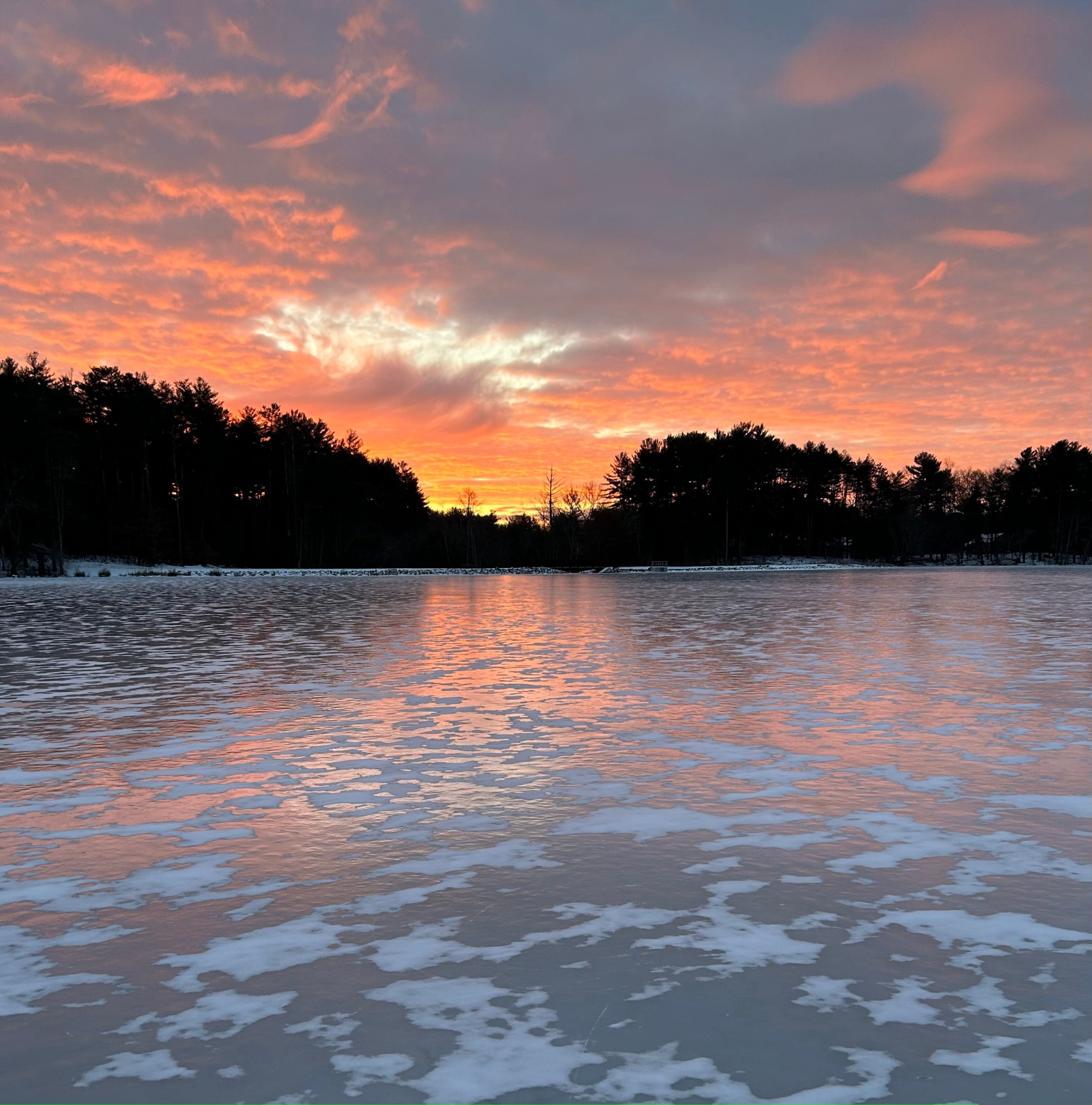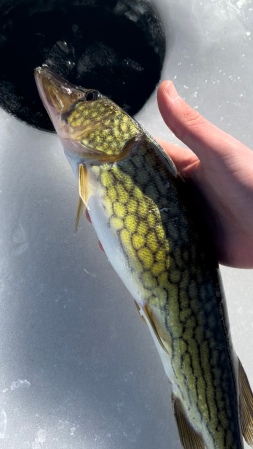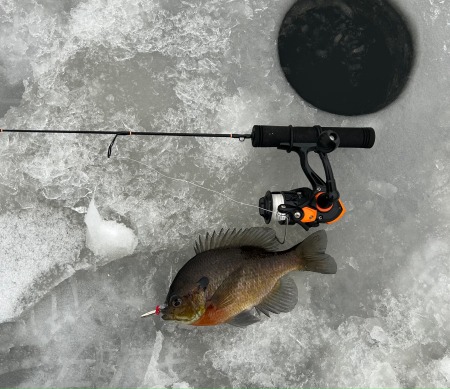It’s easy to lament the season we’ve had thus far in New England. Winter teases us with cold temps and snow squalls, only to be snatched away by mild weather and rain. However, we’ve already had more ice here in northeast Massachusetts than we did all of last winter. Knowing that times like these are fleeting, I’ve taken full advantage of every opportunity I’ve had to get on the hard water.
Early Ice

My first trip was a marathon, beginning at sunrise in one pond, and ending just before sundown at another. Sunrise had me fishing in a run-and-gun style, skating out to the spots with only what I could carry in my hands and in a small backpack. The jigging was fast-and-furious – each drop with a small Swedish Pimple tipped with a wax worm yielded a fish within seconds. This pond isn’t known for big fish, but I was happy to catch a mess of small bass and jumbo bluegills in about 20 minutes of fishing.
The script flipped at the second spot, with my buddy and I opting to play the waiting game with a spread of tip-ups out. The high sun and relentless wind made fishing slow and tough, but we did manage a few fish throughout the day. What the fish lacked in numbers they made up for in species diversity; we caught largemouth bass, chain pickerel, black crappie, yellow perch, and bluegill all in the same general area. The top producer, as I’ve frequently found while ice fishing warmwater ponds, was a marabou jig tipped with a shiner. I have no idea why fish find the stiff, unnatural movement of a heavy jighead more attractive than a plain shiner, but I can’t argue with results!
Second Chance
In late January, temperatures rose and rain came, fooling everyone into thinking there wasn’t any safe ice left. I just about packed the auger away until I caught wind of local anglers still on five inches. Sticking to southeast corners of ponds, where ice is sheltered from the heat of the sun, I found continued jigging success. The only exception, of course, was when I guaranteed a friend immediate action. We went to a spot where I have never failed to catch a fish, especially this season. Though fishing was comfortable in the warm, bluebird conditions, the fish managed to elude us throughout the entire two-hour session.
Takeaways from the ice? First, even though the sun is hardly visible from under the thick ice, low light conditions are always better. Whether it was a dense fog or sunset, less sunlight seemed to equal more active fish. Secondly, ice takes longer to melt than one would think. At the southern end of a pond, safe ice will persist through warm temps and rain as long as temps return to below freezing at night.

And Fly Fishing, Too!
As much as I appreciate a classically cold and icy winter, I also welcome those freak 50-degree February days on occasion. We were lucky to get one of those last weekend, and I wasn’t going to let it pass without getting in my first fly fishing trip of the year. With it being a particularly stressful time in my school career right now, the trip wasn’t so much about the fish as it was relaxing and enjoying the outdoors. So, naturally I chose to fish a gin-clear stream with frustratingly-spooky wild brown trout.
Driving to the stream, I was awed by the difference some elevation can make. The stream is in the hills of central Mass, beginning at about 1,050 feet and dropping to 350 feet in the spot I was fishing. With a road following the brook for its entire length, I got to see how conditions changed across those 700 vertical feet. At 1,050 feet, snow banks lined the road and a few inches of fresh powder coated lawns. There, temperatures dipped to a nippy 28 degrees. A few miles away at 350 feet, the ground was devoid of snow and air temps were in the mid-30s (warming to 58 by midday). It was almost as if I’d gone from the White Mountains to Boston!
Not only are the browns in this stream difficult to catch, but there are also very few of them. I definitely saw more fish than I caught, but even still, I only saw maybe eight fish in five hours of fishing. As with my previous outings at this stream, the fish were everywhere I didn’t expect them to be: shallow, slow runs with sand bottoms that lacked any cover or protection from predators. I vowed to spend the day practicing my Mono Rig game, which turned out to be both a blessing and a curse in chasing the peculiar fish.
Mono Riggin’
More on the Mono Rig: for about a year now, I’ve fished straight monofilament line on my 10′ 3-weight tightline rod instead of “euro nymphing fly line”. The benefits were immediately obvious as I found I had a much better connection to my fly than with a thick fly line. However it was also frustrating. Starting out with the Orvis Clearwater reel, I constantly found that the thin line would slip through the reel’s cage, creating infuriating bird’s nests and many on-the-water meltdowns. Since Christmas, I’ve been using the full-cage Redington Tilt, and have been pleased to find that it fixes the problem. Another new change is the type of monofilament I use. I began with 15 lb Sunset Amnesia, and have loved its sensitivity and lack of memory. For this trip, I switched to 20 lb Maxima Chameleon, as suggested by the masterminds of the Mono Rig at Troutbitten. The Chameleon is much stiffer than the Amnesia, and holds more memory. I prefer Amnesia for its sensitivity while nymphing, but did find that the Chameleon excels when casting heavier and bulkier flies like jig streamers.

Okay, back to the fishing. I started at a small meadow, where I quickly spooked a small brown holding in a shallow pool. Working downstream, I plied hole after hole with my Honey Badger jig streamer, each one looking fishier than the rest. Despite the “sexiness” of the water, it seemed all but devoid of trout – that was, until I hooked up in a set of riffles. When I landed the fish, I was surprised to find it was a handsome rainbow, not a wild brown. Without a self-sustaining rainbow population in the river (at least to my knowledge), this trout must have swam over a mile upstream from the pond where it was stocked during the fall.
Not long after catching the rainbow, time constraints forced me to work back upstream. I started by tightline nymphing with a single Perdigon, but quickly found two issues: first, the stiff Chameleon mono made it tough to get a natural drift. And second, the pools where the browns were holding were too slow to be effectively nymphed without an indicator. So, I decided to compromise. Adding a small yarn indicator to the long leader allowed natural drifts through slow runs, and was easily cast on the Mono Rig.
Eventually I hooked and lost a very nice brown on the nymph, but that was it for the day. Regardless, I was awed by the versatility of the yarn indicator Mono Rig setup. The yarn afforded the delicacy of a dry-dropper rig, but was actually adjustable and didn’t kink the leader. Although I couldn’t cast quite as far as with a traditional fly line, casting felt natural and offered sufficient distance for the small stream. The true advantage was the ease of line management. Drag was nearly nonexistent because I could maintain a tight-line connection to the indicator. This also made for stronger, quicker hook sets (or would have, had I actually fooled more fish).
Despite only landing the lone rainbow, I came off the water feeling refreshed and proud for having discovered a new technique. It was just the kind of variety I needed before temps dropped and snow started to fly again. While I wait for local ponds to harden over again (or thaw – whichever comes first, really), I’ve enjoyed getting creative at the tying desk. I’m particularly excited about a new streamer variation and a couple new dries that I’ve been working on. More on these flies to come soon. Until then, enjoy the variety!






Loving the variety. Haven’t gotten much into ice fishing but I take that time to go through my gear and really decide on my plan of attack for the coming season. Really deciding on what I’m going to focus on! Nice rainbow and even better sunrise/sunset shot!
LikeLike
Thanks Allan! Spring will be here soon!
LikeLike
Wonderful, Spencer!
Carl
LikeLike
Thanks Carl!
LikeLike